-
San Francisco International Film Festival 2011

FILMLEAF GENERAL FILM FORUM SFIFF 2011 COMMENTS THREAD
San Francisco International Film Festival 2011
____________
SFIFF 2011 (April 21-May 5)
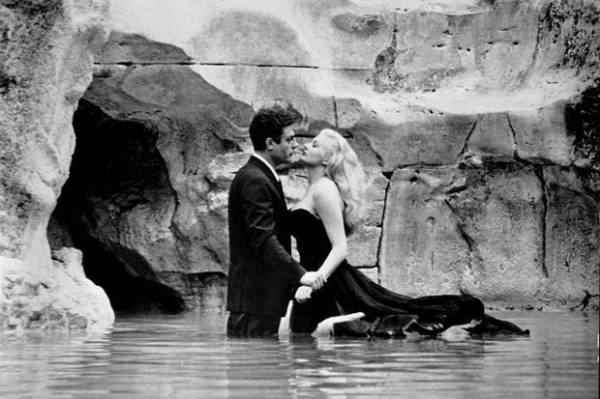
MASTROIANNI AND EKBERG IN LA DOLCE VITA (1960). THE SFFS WILL SHOW A REMASTERED PRINT.
INDEX OF LINKS TO MY REVIEWS OF THE FESTIVAL FILMS:
(Including films seen and/or reviewed previously at NYFF 2110, R-V [Rendez-Vous with French Cinema] 2010 or 2011, or ND/NF [New Directors/New Films 2011); some were seen and reviewed after the film festival in regular theatrical release.)
L'Amour Fou (Pierre Thorreton 2010)
13 Assassins (Takashi Miike 2010)
Arbor, The (Clio Barnard 2010)
Asleep in the Sun (Alejandro Chomski 2010)
At Ellen's Age (Pia Marais 2010) ND/NF
Attenberg (Athina Rachel Tsangari 2010) ND/NF
Aurora (Cristi Puiu 2010) NYFF
Autobiography of Nicolae Ceauşescu, The (Andrei Uticǎ 2010) NYFF
Beginners (Mike Mills 2010)
Better This World (Kelly Duane, Katie Galloway 2011)
Black Bread (Agustí Villaronga 2010)
Black Power Mixtape: 1967-1975, The (Göran Hugo Olsson: 2011) ND/NF
Cave of Forgotten Dreams (Werner Herzog 2010)
Chantrapas (Otar Iosseliani 2010)
Circumstance (Maryam Keshavarz 2011)
City Below, The (Christoph Hochhäusler 2010)
Detroit: Wild City (Florent Tillon 2010)
Dolce Vita, La (Federico Fellini) (Restored print) (no review)
Dish and the Spoon, The (Abigail Bognall 2011)
Foreign Parts (Verena Paravel, J.P. Sniadecki, 2010) NYFF (no review)
Future, The (Miranda July 2011)
Green Wave, The (Ali Samadi Ahadi 2010)
Hands Up (Romain Goupil 2010) R-V 2011
Hospitalité (Koji Fukada 2010) ND/NF
I'm Glad My Mother Is Alive (Claude Miller, Nathan Miller 2009) R-V 2010
Incendies (Denis Villeneuve 2010) ND/NF
Journals of Musan (Park Jung-bum 2010)
Let the Wind Carry Me (Kwan, Chiang 2010)
Love in a Puff (Pang Ho-cheung 2010)
Meek's Cutoff (Kelly Reichardt 2010) NYFF
Microphone (Ahmad Abdalla 2010) ND/NF
Mill and the Cross, The (Lech Majewski 2011)
My Joy (Sergei Loznitsa 2010) NYFF
Mysteries of Lisbon (Raúl Ruiz 2010) NYFF
On Tour (Matthieu Amalric 2010)
Page One: Inside the New York Times (Andrew Rossi 2011)
Quattro Volte, Le (Michelangelo Frammartino 2010) NYFF
She Monkeys (Linda Aschan 2010)
Silent Souls (Alexei Fedorchenko 2010) NYFF
Sleeping Beauty, The (Catherine Breillat 2010) R-V 2011
Something Ventured (Dan Geller, Danya Goldfine 2011)
Tilva Rosh (Nikola Lezaic 2010)
Tiniest Place, The (Tatiana Huezo 2011)
Trip, The (Michael Winterbottom 2010)
Useful Life, A (Federico Veiroj 2010)
Walking Too Fast (Radim Spacek 2009)
The San Francisco International Film Festival, SFIFF 54, runs from April 21 to May 5, 2011, and has announced its program today with the usual press conference on the beautiful top floor of the Westin St. Francis Hotel in San Francisco, with Graham Leggett, Executive Director of the SFFS, presiding in his fifth year at the Society's helm.
The San Francisco Film Society's full online program of the festival films begins here.
I will plan to attend and review films.
There are 189 films from forty-odd countries.
Opening night film is Mike Mills' Beginners with Ewan McGregor and Christopher Plummer. Centerpiece is Azarel Jacobs' Terri. Closing night film is Matthieu Amalric's On Tour (Tournée).
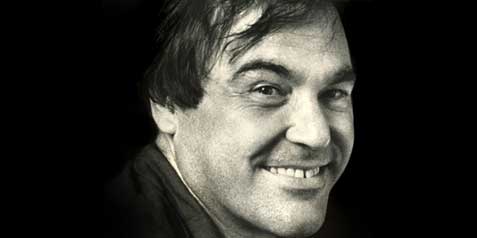 ...........
...........
OLIVER STONE
AWARDS.Oliver Stone will be the recipient of the Founder's Directing Award. Special awards are going to legendary screenwriter Frank Pierson; Persist ence of Vision Award to artist Matthew Barney; the Mel Novikoff Award for contribution to public appreciation of film goes to film restorer/showman Serge Bromberg (whose Henri-Georges Clouzot's Inferno was in the SFIFF last year).

TERENCE STAMP BEING HONORED AT SFIFF 54
Terence Stamp will receive the Peter J. Owens acting award. Stamp will also be honored with An Evening with Terence Stamp at the Castro Theatre at 7:30 pm, Friday, April 29, 2011.
SCREENING TIMES AND LOCATIONS ARE GIVEN FOR THE FILMS AND ARE:
KABUKI CINEMAS (main festival venue)
1881 Post Street
San Francisco, CA 94115
PFI PACIFIC FILM ARCHIVE (East Bay venue)
2575 Bancroft Way
Berkeley, CA 94702
NEW PEOPLE (near the Kabuki)
1746 Post Street
San Francisco, CA 94115
CASTRO THEATER (special events venue)
429 Castro Street
San Francisco, CA 94114-2019
Last edited by Chris Knipp; 05-04-2015 at 11:00 PM.
-
Agustí Villaronga: Black Bread (2010)
Agustí Villaronga: Black Bread (2010)
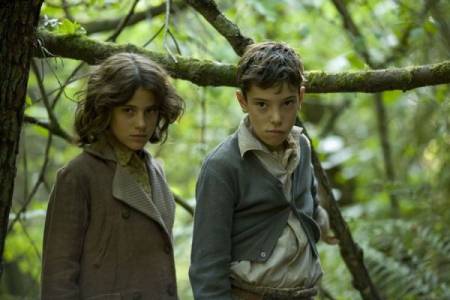
A boy wades past fascism and rural poverty in a strong Catalan coming-of-age film
Agustí Villaronga wrote and directed this austerely beautiful Catalan coming-of-age film based on a novel by Emili Teixidor with echoes of Clément's Forbidden Games and Dickens' Great Expectations and a setting -- a child's rural world during the grim days after the Spanish Civil War (1944) -- that links it with Guillermo del Toro's Pan's Labyrinth. But while del Toro's film is Gothic and surreal, Teixidor's, apart dream sequences and flight metaphors, impresses in both its narrative and its imagery with a stark simplicity worthy of Italian neorealism, overlaid with greater layer of moral ambiguity. Again as in Pan's Labyrinth, Sergi López plays the local fascist Alcalde, this time a less clearly sadistic one.
At the center is 11-year-old Andreu (Francesc Colomer), who at the outset witnesses a shocking crime. He sees a hooded figure kill a man, toss him in a covered wagon, then blindfold the horse pulling the wagon and cast the lot of them all off a cliff with a boy also trapped inside. Andreu's father Farriol (Roger Casamajor) is suspected of this shocking deed, perhaps because he has an anti-fascist background and anyone not fascist is now demonized. Farriol goes into hiding and Andreu is sent to live with his grandmother (Elisa Crehuet) in a houseful of widows. Andreu's lean, handsome father gives his son many inspiring peptalks about keeping the moral high ground, but all the while his own character remains somewhat suspect. Eventually Andreu will also turn away even from his long-suffering mother Florencia (Nora Navas) when he is adopted by a rich, plump Miss Havisham figure, Mrs. Manubens (Merce Aranega).
At school the teacher is a monomaniacal fascist drum-beater and alcoholic (Eduard Fernandez), who even sleeps with Andreu's feral, maimed but beautiful cousin Núria (Marina Comas) -- her hand has been blown up by a bomb. Yet he is not without redeeming qualities, and Fernandez conveys complexity when he advises Andreu to leave his past behind and seek a better life. Núria and Andreu become frequent companions, and roam the mysterious forest together (this is the Forbidden Games part). Here also he meets an older boy (Lázaro Mur), first spotting him bathing naked in that forest, who has TB, lives in the monastery, and imagines he has angels' wings. The none-too-subtle bird imagery extends to a pet in a red wooden cage kept by Andreu's dad. Obviously Andreu is to fly away, and the comsumptive boy can only dream of it.
It's Andreu's mother who approaches Mrs. Manubens when Farriol has been found and taken away. Not much comes of that, and Farriol is taken to Barcelona and shot, but Mrs. Manubens warms to the idea of adopting Andreu.
All this happens with a kind of precipitous energy fueled by the intense but simple cinematography, the understated, compelling acting, the emotional scenes, and the prevailing sense of fear and moral ambiguity in which Andreau remarkably, with the innocence and determination of a boy, sails through unharmed, or at least capable of accepting adoption and going to a good school that will change his future.
It's not necessary to undermine the rich accomplishment of Pan's Labyrinth to praise Black Bread, but it does shine forth precisely because of its simplicity and completely lack of the kind of baroque flourishes del Toro relishes. There is some strong handheld camera work, but also long tracking shots. The cinematography of Antonio Riestra is classic and the editing by Raul Roman is smooth and swift.
According to Jonathan Holland's review in Variety (and I take his word), this is Villaronga's "most mainstream film" but still "retains his trademark subversive edge." Holland also points to the way "as a depiction of rural poverty" the film is "impressive: The darkly lit, richly textured interiors seem to be an extension of the beautifully lensed natural landscape." Something about the simple dignity of the people offsets the danger and moral uncertainty of events and gives one a sense of humanistic tradition even in a world where all's gone mad and main characters like Andreu and his parents reject the comforts of religion.
Black Bread/Pa negre, whose sense of style is timeless, understandably won many awards, an unusual number for a film in Catalan, both at its San Sebastián festival debut and with nine Goyas after Spanish theatrical release including best picture and best director and prizes to most of the main actors. Both Francesc Colomer, who plays the young lead, and Marina Comas, who plays his cynical pal Núria, won "most promising" awards. Colomer, who is in nearly every scene, has a limpid confidence that stays with you as a memorable presence long after the final scene.
The film showed earlier this year in the US at the Palm Springs festival. Seen and reviewed as part of the San Francisco International Film Festival 2011.
SFIFF Screenings
Fri, Apr 29 3:00 / Kabuki
Mon, May 2 6:00 / Kabuki
Wed, May 4 9:15 / Kabuki
Last edited by Chris Knipp; 05-04-2015 at 10:50 PM.
-
Clio Barnard: The Arbor (2010)
Clio Bernard: THE ARBOR (2010)
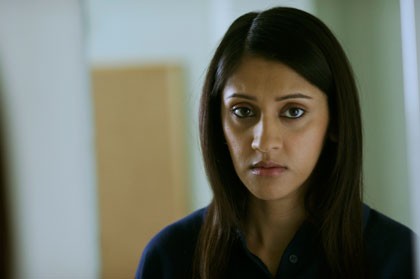
MANJINDER VIRK IN THE ARBOR
Documentary and realism seamlessly blend in the portrait of a working-class playwright
Location shots, real people, and actors are deployed in a seamless amalgam in this recollection of of the talented but short-lived alcoholic working-class playwright Andrea Dunbar, from Bradford, West Yorkshire. Filmmaker Clio Barnard first spent two years recording interviews with Dunbar's family and friends,. Then she staged actors lip-synching the interviews as monologues, sometimes in a group scene -- a technique known as "verbatim theater" that arguably works more seamlessly because of Bernard's use of filmed settings. Barnard also staged parts of one of Dunbar's plays out near "The Arbor," ther part of the Yorkshire housing estate where Dunbar grew up and of which her plays speak. This is also the name of Dunbar's first play. Another one, Rita, Sue and Bob Too, was made into a reportedly excellent film. After a while, thanks in part to the excellent editing of Ole Birekland, you don't know who's the real person and who's an actor (because vintage footage of the people is there too). This creates a kind of Brechtian "Alienation Effect" that paradoxically makes it all more real and memorable. In the course of compensating mentally for shifts of format and perspective, you wind up projecting yourself into Andrea Dunbar's world.
It's a tough trip. Dunbar grew up in the Butterfield Estates during the decline of the textile mills, writing her first play at fifteen. She was already experiencing the prevailing racism, alcoholism and domestic violence. Eventually, by the time she died at 29 of a cerebral hemorrhage, she'd had become a heavy drinker and had three children by three different fathers. The eldest, Lorraine, played here by the sad-eyed, insinuating Manjinder Virk, was a dark-skinned, pretty girl whose dad was of Pakistani origin. She was to write no plays, but otherwise would duplicate her mother's unfortunate model of children by different fathers, drug addiction instead of alcoholism, and imprisonment for the causing the death of her child by extreme negligence.
Editing is a key factor here, but all elements are so smoothly handled you become unaware of the many layers and modes at work. Over-titles identifying the main speakers when the first appear also help to create the desired confusion. In news footage where the family is interviewed after Andrea's first London success, her real dad bears a quite striking resemblance to the father in the staged play. At the play, many people, presumably current residents of the estates, stand around to watch -- another way boundaries are broken. Ronnie Schieb calls this "a must-see entry in the ongoing evolution of cinematic formalism," but this "formally inventive" and "socially revelatory" exploration, neither formal nor abstract in the playing out, never seems anything but real, down to the sometimes almost impenetrable accents of the recorded speakers whose voices flow through the scenes. Very good foreground and ambient sound contributes to the seamless effect, of course. Credit here to Dolby Digital sound designer Tim Barker and re-recording mixer Richard Davey.
There is a Rashomon-like aspect as one gradually watches Andreas's story unfold from multiple sources, including the various fathers of her children, and the most personal moments come with Lorraine's unfolding confessions. As Peter Bradshaw of The Guardian wrote about the film last spring, Barnard's "technique produces a hyperreal intensification of the pain in Dunbar's work and in her life," and this pain becomes most vivid as we realize that in Lorraine's life Andrea's tragedy "was replicated, almost genetically." Bradshaw makes another good point: Dunbar's story, and her success as a teenage playwright in Max Stafford-Clark's Royal Court, challenges a lot of what we assume about gritty realist theatre or literature from the tough north," because the plays are usually produced "by men whose gender privileges are reinforced by university." They become stories of how they got out. But Dunbar never got out.
The Arbor, Barnard's debut feature, got a raft of nominations at BAFTA and the London Critics Circle, and two actual awards, one at Sheffield's documentary festival (Innovation Award) and the British Independent Film award for Best Achievement in Production. It's not a cheerful watch, but it's a very compelling one and a remarkable accomplishment by Clio Bernard -- as well as by the principal actors, Manjinder Virk, Christine Bottomley, Neil Dudgeon, Monica Dolan, Danny Webb, Kathryn Pogson, Natalie Gavin, Jonathan Haynes, Jimi Mistry, George Costigan. Try as you may, you will not spot their lips out of sync.
The 94-minute The Arbor won Barnard a best new documentary filmmaker prize at 2010's year’s Tribeca Film Festival. Seen and reviewed as part of the San Francisco International Film Festival, April 2011. Limited US theatrical release by Strand began April 27, 2011. The UK release was October 22, 2010.
SFIFF Screenings
Sun, Apr 24 8:45 / PFA
Sun, May 1 7:15 / Kabuki
Wed, May 4 7:15 / Kabuki
The Arbor was released April 27, 2011 at Film Forum in New York. Online the NYTimes review by Jeannette Catsoulis is accompanied by a filmed interview with the filmmaker, Clio Barnard.
Last edited by Chris Knipp; 05-04-2015 at 10:47 PM.
-
Radim Spacek: Walking Too Fast (2009)
Radim Spacek: Walking Too Fast (2009)
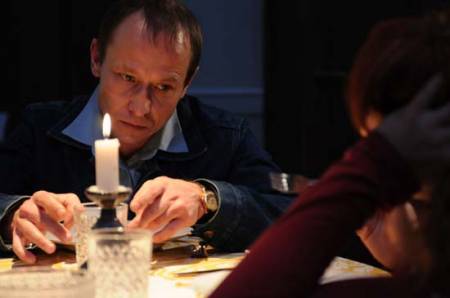
ONDREY MALÝ IN WALKING TOO FAST
1980's meltdown of a secret police sociopa
Radim Spacek's Walking Too Fast has been described as a "political thriller," but its agenda is different. It has an abstract, absurdist quality that undercuts the suspense and excitement necessary to a thriller. Its mood is deliberately alienating, unlike Von Donnersmarck's The Lives of Others, where we are drawn into the most minute details. There are similarities between the two films. Here too there is an intellectual under investigation, Tomás (Martin Finger), a dissident writer, a big, long-haired man with a nice house full of books, a wife, and a mistress, Klara (Kristina Farkasova), a confident and pretty ginger-haired factory-worker. There's not much about what he writes, though, or who his friends are. But he's repeatedly menaced and beaten, his adultery revealed to his wife, who kicks him out. He's offered the opportunity to leave the country with his family, which he initially refuses on moral grounds. There's little about the actual process of surveillance that is so central to Von Donnersmarck's film.
This movie seeks primarily to show how the system of repression (it's set in 1982) destroys the people who enforce it, and it does that through a single compelling but repellent character, Antonín (Ondrej Malý), a star operative of the secret police (StB). He falls for the writer's girlfriend Klara, a useless passion that seems to lead to his ultimate meltdown, but most of his time is occupied with senseless violence and menace. Malý is a little, wiry, ferret-like man who resembles an Eastern European Matthieu Amalric. He has Amalric's face with the life and the handsomeness drained from it. He has Amalric's manic intensity but none of his warmth and vulnerability. Instead there's something genuinely scary about him. The film's "suspense" is watching to see what he will do next. Malý, who's in nearly every scene, is the chief reason for watching this movie, which may mean more to Czechs otherwise than to anybody else. They can read worlds into it. Outsiders will miss a convincing story, some excuses for what is going on, for how we get from point A to point B. The movie's structure is solely the structure of Antonín's downward spiral, spurred by discontent with everything, growing physical and psychological problems and his obsession with Klara. As one reviewer, Jason Pirodsky, put it, Antonín is "a Travis Bickle-like sociopath." But instead of being an alienated loner, he's part of the state machine, and he's running off the rails.
Walking Too Fast (whose original title Pouta means "The Ties That Bind") systematically robs the secret police's intelligence-gathering process of all logic. When he pulls in Tomás to an empty, low-ceilinged interrogation room, Antonín says, "Do you know why you're here?" but he doesn't, and Antonín doesn't tell him. We see Antonín and a group of his cohorts getting drunk together -- another stage for unnerving, mad behavior -- and it shows they are afraid of him but don't admire him. Eventually he beats up a lot of people, singlehanded, onscreen. But he also has panic attacks, and after burning one man with a cigarette he burns himself too. He carries a plastic bag to breathe into to ease the panic attacks. At least one of these attacks occurs in the middle of beating someone. No doubt about it, Antonín isn't having a good time.
Walking Too Fast has some of the qualities of a film noir or a whodonit, though its loser protagonist brings his troubles on himself and earns no shred of sympathy from the audience. However this is where Malý's cold intensity as an actor comes in. He makes Antonín an inexplicable force of nature, a man possessed by an energy that's destroying him.
Though the beatings are repeated without the sense of a buildup to anything, there are good scenes in Walking Too Fast. The ones where Antonín forces his wife to move out and uselessly corners Klara and proposes an affair are particularly memorable. There's good work from all the cast. Lukas Latinak is fine as Antonín's mellower, tricky Slovak cohort and so is Lubos Vesely as a timid intellectual forced to play informant. I particularly liked the Eighties-ish electronic score by indie musician Tomas Vtipil, which sets up the uneasy mood of the scenes and provides an unsettling jauntiness to the closing credits. The cinematography of Jaromir Kacer is impeccable. I just wish the writer, Ondrej Stindl, had put a dash more humanity and three-dimensionality into the script. Writing ultimately makes or breaks a film and here a little more story logic would have expanded the potential audience.
Pouta took home a raft of honors at the Czech version of the Oscars. It has appeared in half a dozen international festivals and opened theatrically in the Czech Republic in February 2010, but it sold fewer than 17,000 tickets. It may have a better life as a DVD when viewers can take breaks from its 142-minute length. Seen and reviewed as part of the San Francisco International Film Festival, April 2011.
SFIFF Screenings
Fri, Apr 22 8:45 / Kabuki
Sun, Apr 24 3:00 / Kabuki
Mon, May 2 8:30 / PFA
Last edited by Chris Knipp; 05-04-2015 at 10:42 PM.
-
Ali Samadi Ahadi: The Green Wave (2010)
Ali Samadi Ahadi: The Green Wave (2010)
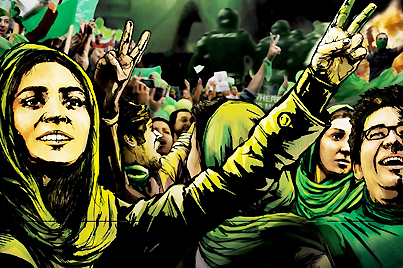
A tragic first chapter in the Middle Eastern revolts which awaits a sequel
Iranian expatriate Ali Samadi Ahadi's documentary concerns a crucial moment in recent Middle Eastern history: the so-called Green Wave (also known as the Green Revolution) was the reform movement in Iran among intellectuals and young people in the spring and summer of 2009 that hoped to take out President Mahmoud Ahmadinejad and replace him with reformist Mir-Hossein Mousavi through democratic elections. There was a promise of a new blossoming of democracy. Thousands braved the streets, like demonstrators in Egypt in January 2011. When Ahmadinejad won by a landslide, indicating a fixed election, the strong negative response was brutally repressed. Though it failed, this movement, with its reliance on new media like Twitter and Facebook, may have been the first strong example of the spirit of revolt against repressive regimes that is currently sweeping across the Arab world. Ahadi integrates Facebook reports, tweets and videos posted on the Internet into the film along with drawings and animations as well as archival street footage of the cell-phone kind often seen on Al Jazeera and talking heads, which include young dissidents beaten and imprisoned during the uprising -- and in a formal interview among many, Shirin Ebadi, the stolid but forceful Iranian Nobel Peace Prizewinner.
Despite all this The Green Wave, not entirely through the fault of the filmmaker perhaps, is both essential and disappointing. It is not only an anguished cry of despair but lacks the seeds of new hope, and there's more weeping than shouting, so you wonder where the courage went and what can be and is being done now.
The format arouses comparisons with Ari Folman's Waltz With Bashir, the vivid Israeli film that combined animation with documentary, as well as Persepolis, Vincent Paronnaud and Marjane Satrapi's animated summing up of her graphic novel autobiography. The Green Wave's drawings and animations may show some stylistic debt to both of these, but this film is not as involving and strong as they are, nor, despite the use of so-called "real-time" Twitter or Facebook entries, is it as innovative.
Nonetheless Ahadi does his conventional job of describing the events of 2009 in Iran well, with many voices heard from and a day-to-day account of the main events. The disappointment is in the context of more recent revolts, the failure to delve deeper into the movement's orgins, its leadership, its organization, and its current status. Mostly this film turns out to be a lament, one long wail, underlined by the frequent use of a cello background. There are many tears, and much hopelessness. And there is no great subtlety in the emotional propaganda. As Variety critic Leslie Felperin <a href="http://www.variety.com/review/VE1117944137/">notes,</a> "Characters in the animated material, for instance, are often posed in such heroic stances they recall propaganda posters from the Soviet era," and Ali N. Askin's string-heavy score "attempts to milk the tear ducts with such ferocity, some [audiences] may feel bullied by the string section."
The most memorable segments are the excerpts of blogs voiced by actors Pegah Ferydoni and Navid Akhavan and brought to life with animations by Ali Reza Darvish in as style like that of a graphic novel. Two of the accounts (neither identified by name) are by a youthful protester who was later arrested and tortured, and a young female supporter of who works for opposition candidate Mir-Hossein Mousavi's election campaign. The film establishes what is already well known: that polls indicated Moussavi would win by a wide margin and that the negative reaction to his questionable defeat was brutally repressed, with the blessing of Iran's supreme religious leader, Ayatollah Sayyed Ali Khamenei. The shot of Khamenei putting the seal on Ahmadinejad's fake reelection with a kiss is one of the most repellent in the film.
Also interviewed, besides Shirin Ebadi, are journalist and Green Revolution eyewitness Mitra Khalatbari; law professor Payam Akhavan; human rights lawyer Shadi Sadr; journalist/blogger Mehdi Mohseni; and Shiite cleric Mohsen Kadivar -- all strong opponents of President Mahmoud Ahmadinejad. Some may need to know that Ahmadinejad is unpopular and, like the Arab leaders, is a despot. Most who follow world events will be aware of this, and may want a little more searching reportage than Ahadi provides. It might be more interesting just to know how he made this film, and where. He lives in Germany, where the film was produced.
The most hopeful note we get comes toward the end of the film when former UN prosecutor Payam Akhavan, calls the Green Wave as “seismic shift, the democratic tidal wave” and says that eventually the oppressors who quashed it, whose actions are recorded here and elsewhere, will be brought to justice. "They have to understand that their crimes are being documented, are being recorded, and a day will come when they have to answer.” Yes, but where, how, and when? When will the predominantly youthful population of Iran have a voice?
The Green Wave debuted in Germany, where it had a theatrical debut in February 2011. Its US debut was at Sundance 2011. Seen and reviewed as part of the San Francisco International Film Festival, April-May 2011.
SFIFF Screenings
Sat, Apr 23 4:00 / PFA
Sun, Apr 24 2:45 / Kabuki
Mon, May 2 6:15 / Kabuki
Last edited by Chris Knipp; 05-04-2015 at 10:41 PM.
-
Lisa Aschan: She Monkeys (2010)
Lisa Aschan: She Monkeys (2010)French
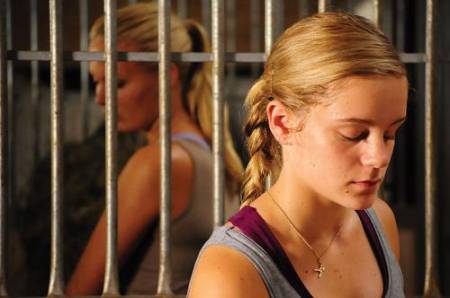
LINDA MOLIN AND MATHILDA PARADEISER IN SHE MONKEYS
Rivalry and friendship between budding girls on a sports team
Swedish first-timer Lisa Aschan's She Monkeys is like Céline Sciamma's 2007 French coming-of-ager Water Lilies (SFIFF 2008), about two girls who bond around a challenging female sport, in Water Lilies water ballet, and here, equestrian gymnastics. There is a popular, or more confident, girl, and the more timid newcomer, though the distinction gets twisted along the way when the strong girl turns out not to be invincible. Here it's introverted Emma (Mathilda Paradeiser) and more experienced equestrian Cassandra (Linda Molin), who become playful friends, and later when Emma turns out to be strong and promising, rivals. This is different from the French film in that the two challenge each other to more real wrongdoing, and Emma has a seven-year-old sister Sara (Isabella Lindquist), whose desire to become a woman and precocious lust for her babysitter cousin Sebastian (Kevin Caicedo Vega) leads her to extravagances of her own. In fact when the energy begins to fade in the Cassandra-Emma relationship, Sara comes in handy by providing comic relief that also pushes boundaries a bit.
In Water Lilies, Marie (Pauline Acquart) isn't on the water ballet team, but thinks she wants to be. She admires Floriane (Adele Haenel), a popular girl on the team who has the boys running around after her. She Monkeys provides some scenes of the equestrian training, but Cassandra and Emma hardly seem interested in boys, who aren't really around much, as they are at Water Lilies' swim center. Floriane is a big flirt, though it's just a pose; another girl, Marie's former friend, is closer to really getting laid. In both of these films, one of the girls turns out to desire the other sexually.
She Monkeys may push boundaries a bit more, but it is less successful at showing its two "girlfriends" in a real social context than the French film is. Nonetheless She Monkeys clearly establishes that Lisa Ashan, whose first feature this is as Water Lilies was Sciamma's, is a talent to watch with a distinctive style.
Apflickorna (the original title) is the fifth and last of a series of low budget first films chosen by competition for the Swedish Film Institute's Rookie Project. It won the Gothenberg, Sweden festival's Nordic film prize and critics' award. Seen and reviewed as part of the San Francisco film festival of 2011, this debuted in the US at Tribeca in 2010.
As Tribeca wrapped it was announced She Monkeys won the Founders Award for Best Narrative Feature. This included $25,000 in award money and the "art award" of a painting by Robert De Niro, Sr. entitled "Anna Christie Entering the Bar, 1965-1967."
SFIFF Screenings
Mon, Apr 25 7:15 / Kabuki
Tue, Apr 26 8:45 / Kabuki
Last edited by Chris Knipp; 05-04-2015 at 10:39 PM.
 Posting Permissions
Posting Permissions
- You may not post new threads
- You may not post replies
- You may not post attachments
- You may not edit your posts
-
Forum Rules
...........







 Reply With Quote
Reply With Quote





Bookmarks